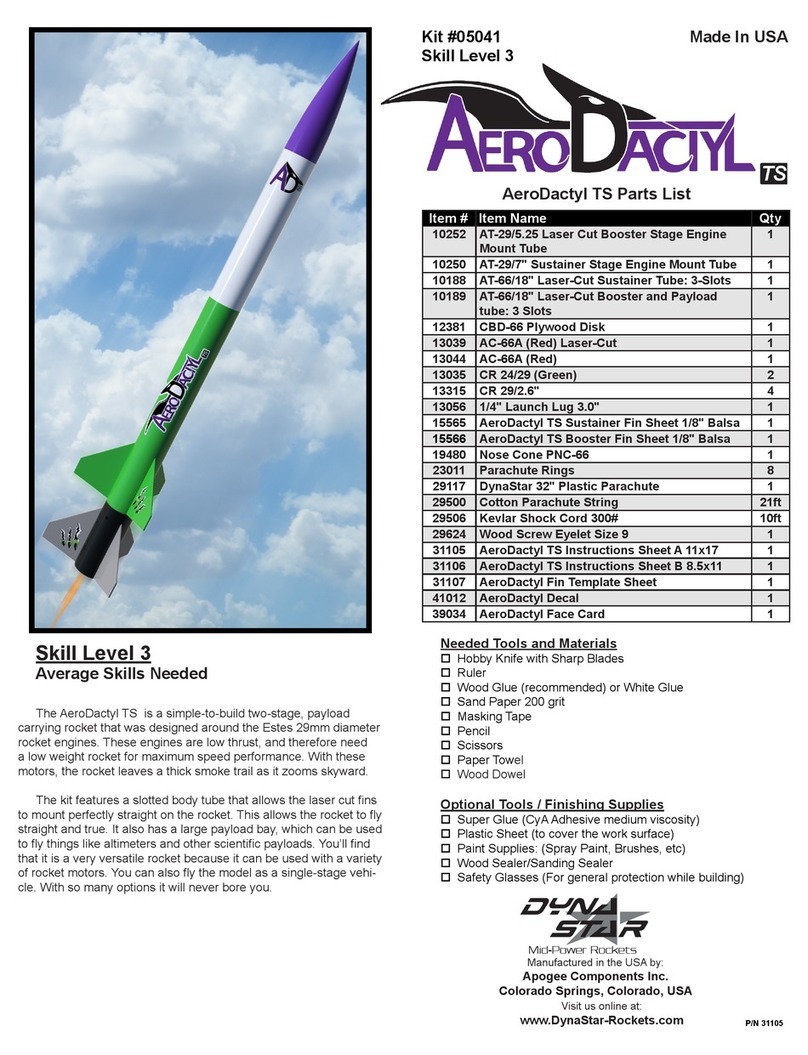
Page 2
Grappler Rocket Assembly
1. Using 400 grit sandpaper, fine sand the
balsa die-cut sheets before removing the fins.
Carefully remove all the pieces from the balsa
sheet by freeing the edges with a sharp hobby
knife.
2. Group the three fins together, and gently
sand the edges as shown in the illustration.
3. You can apply sanding sealer to the
surfaces of the balsa fins. Coat both sides at
the same time to minimize the chances of the
fins warping. Do not allow the sanding sealer
to get on the root edge of the fin. This could
prevent the fin from bonding well to the body
tube when it is glued on later in step 17. Set
them aside to dry completely. When they are
dry, sand the sealer smooth until you get a de-
sirable surface finish. You may need to repeat
this step several times depending on the level
of quality you wish to achieve.
4. Mark a line on the outside of the motor
mount tube 2 1/4 inches (57mm) from one
end. This end will be the aft end of the rocket.
Make this line about 1/8 inches (3mm) long as
the picture shows. Take a hobby knife and cut
a 1/8 inches (3mm) long slit in the engine tube
along the line as shown in the picture. Insert
one end of the motor hook into this slit.
5. Make a mark 1 1/2 inches (38.1mm)
from the rear of the engine tube. Locate the
yellow airframe sleeve. Apply a layer of glue
around the tube for a 2 inch length, forward
of the mark that you made. Slide the yellow
sleeve over the engine hook and onto the
engine tube until the rear end of the sleeve is
lined up with the mark. Apply a fillet of glue to
both ends of the sleeve (Be sure that the en-
gine hook remains perpendicular to the engine
tube).
6. Now mark 1 1/8 inches (29mm) from the
rear of the engine tube. Find one of the large
green rings that fits over the 24mm diameter
engine mount tube. Make a thin layer of glue
around the engine tube behind the mark you
made. Take the green ring, slide it over the
engine hook, and then onto the engine tube
until the rear end of the ring is lined up with
the mark you made (Be careful of the hook as
above).
7. Remove one of the three large centering rings
from the die-cut card sheet and apply a bead of
wood glue 71/2 inches (17.8 cm) from the front end
of the engine tube, Slide the cardboard centering
ring into the bead of glue. Check to be sure the ring
is aligned straight on the tube. Allow the glue to dry.
Engine Hook Size “A” Length
D-Engine 2-1/4” (57mm)
Do NOT use the Estes E9 in this rocket.
It doesn’t have enough thrust to safely lift
this big rocket kit.
1/8” (3mm)
1-1/8” (29mm)
7 1/2” (17.8m)
1-1/2”
Yellow Sleeve


























